Lavender corn snakes are quickly growing more popular due to their unique and beautiful colors, along with their docile nature. Although corn snakes are often confused with coral snakes, this is not a problem for lavender com snakes. They are a morph from regular corn snakes, or in other words, their special colors are due to selective genetic breeding.
They are easy to find among breeders and pet stores and are relatively cheap. Lavender corn snakes cost about $60 but can cost anywhere from $40 to $80 depending on where you purchase them.
As previously mentioned, lavender corn snakes are naturally docile. They make great pets for people who haven’t owned snakes before, including children. Their bright and captivating purple color makes them a great first pet for kids, and they’re more active than other breeds of snakes. This means they’re fun to watch, along with being easy to care for.
Lavender corn snakes are bred to be purple in appearance, but aside from their unnatural color, they resemble other variations of corn snakes very closely. They’ll grow between four and five feet long, and will develop a darker tinted pattern on their backs most of the time. Their underside should be very plain, giving them a simple belly without any patterns.
Although this is their usual appearance, lavender corn snakes can be bred to be more colorful or have different patterns. This means that there’s a wide variety of appearances to choose from and that you could end up with a snake that looks very unique when compared to others of its species.
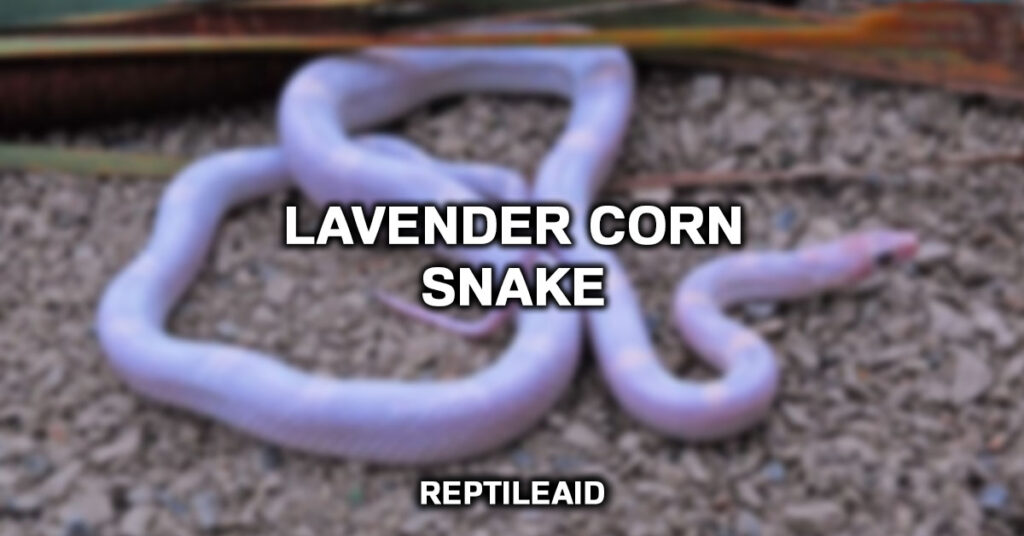
Lifespan
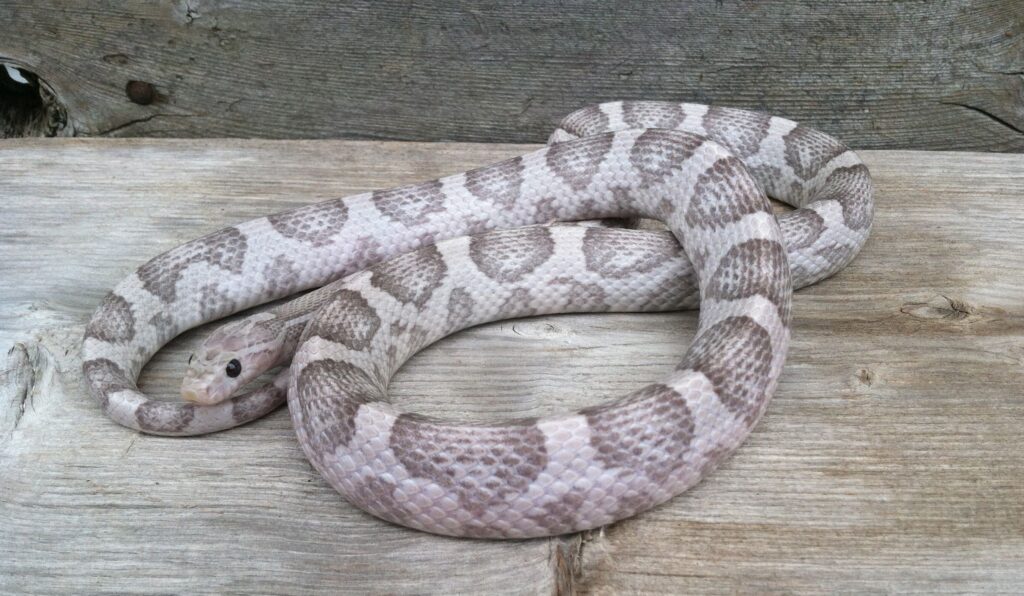
Lavender Corn Snakes are a very easy breed to look after. If properly cared for, they can live a long and healthy life of over 20 years while in captivity. Newly hatched lavender corn snakes require very little space when compared to their adult counterparts, and can live happily in a shoebox-sized aquarium.
Size
They’re only about eight to twelve inches long at first, they will quickly grow to be between three and five feet long within two years, so starting with a large aquarium will save you from having to make a second purchase in the long run.
Tank Setup
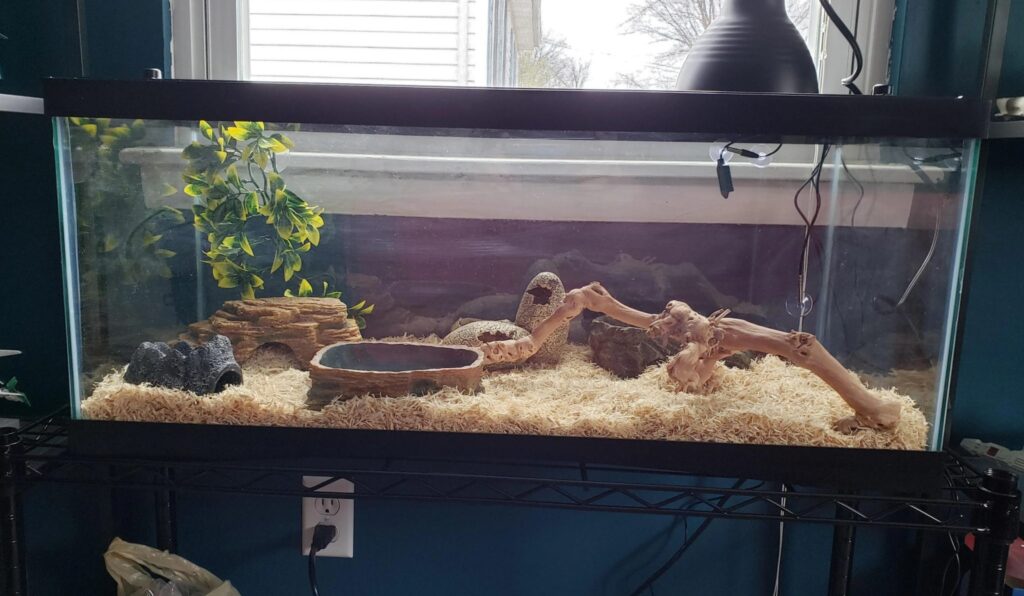
A fully grown lavender corn snake will need a tank that can hold at least 20 gallons or more, though having a 40-gallon terrarium will give your snake plenty of room for all of its needs. Although you might feel tempted to spoil your pet snake and splurge on a larger tank, it’s not recommended to go above the 40-gallon maximum.
The extra size might seem spacious, but lavender corn snakes could feel exposed and unsafe in a tank that’s too big for them. Corn snakes are not social creatures, so if you have to choose between getting a bigger tank and having two snakes share an enclosure or buying them separate and smaller terrariums, purchase separate tanks.
The only time lavender corn snakes should be kept together is to breed them, otherwise, it would just cause them needless stress.
Regardless of what size tank you get, their habitat should come with a tightly sealed top. Lavender corn snakes are slender and crafty, making them master escape artists, and they can easily escape from their tanks if it isn’t secured correctly. Although screen tops allow for plenty of ventilation, your pet snake could rub its nose raw on the mesh if the top is within its reach.
Expert Tip: If you do use a screened top, make sure it’s too high for the snake to get to. Another alternative is a front-opening terrarium, which is easy to clean, secure enough to prevent your pet from escaping, and keeps both heat and humidity in the tank.
Finally, many owners use glass aquariums as habitats for lavender corn snakes. This is the least recommended option, but if you do use it, make sure that three out of the four glass walls are covered to give your pet a sense of privacy and security.
Lavender corn snakes need plenty of hiding places in their habitats to feel safe and comfortable. Although this breed of snake is very active and has a lot of curiosity, they’ll need two or more places they can hide. These hiding spots are meant to make them feel secure if they feel threatened or uncomfortable.
Preferably, there should be at least one warm hiding space and at least one cool hiding space so that your pet won’t have to choose between comfort and security. The hiding spots should be big enough for them to fit into, but not spacious enough for them to feel exposed.
Lavender corn snakes like the feeling of pressure that their hiding places provide, so they’ll often be in there despite not feeling scared or in danger.
Unlike other reptiles such as iguanas or bearded dragons, lavender corn snakes don’t need any special UV lighting in their habitats. They’re most active at dawn and dusk, so whatever natural light sources in their room will be enough.
Although it’s debated if giving your pet lavender corn snake UV lighting will help them feel happier or produce health benefits, there’s no evidence that it does so. The most that a UV light would provide is visual enhancements.
Many lavender corn snake owners use UV lighting to bring out the colorations of their snakes, especially for those who have grown older and have started to lose their brightness. Lavender corn snakes’ patterns will fade over time, so using a UV lamp could improve their looks, but it won’t provide any health benefits and is therefore unnecessary.
However, using UV light with an albino or red-eyed lavender corn snake could be detrimental to their health, as they’re more likely to be sunburned or damaged from the intense light.
Substrate
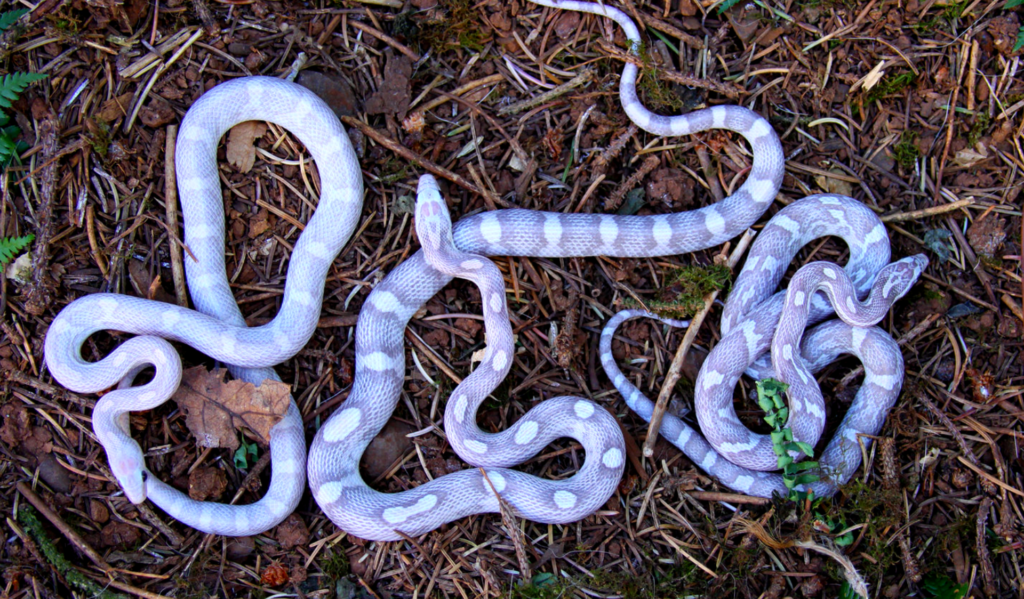
A substrate is the bottom lining of your pet’s terrarium. There’s a huge selection of substrates you can use but aspen is the most recommended for lavender corn snakes. This type of softwood will lock in humidity, along with providing your snake with the ability to burrow and hide.
Being able to burrow is important to the happiness of your pet snake, so consider that when choosing what type of substrate to use. Some owners line the bottom of their pet snake’s tank with newspapers or paper towels, but this is not recommended. It’s affordable and easy to replace, but it lacks attractiveness and isn’t a good material for your pet to burrow into.
Reptile carpet, a felt mat designed for reptiles such as snakes and lizards, is another popular option. It’s soft, durable, and washable, but it’s not at all made for burrowing. Since lavender corn snakes like to burrow, they’ll often find ways beneath the mat to satisfy their needs.
Layering reptile carpets could help prevent them from rubbing against the hard bottom of the tank, but it’s cheaper and easier to use a separate substance for your pet snake, so it’s recommended to use an entirely different substrate altogether.
Cypress mulch, hemp, and coconut fiber are all good options for a substrate. However, never use sand to line the bottom of your lavender corn snake’s enclosure, or else they could ingest it, which could cause intestinal blockages and digestive problems.
Although many pet stores have pine and cedar shavings readily available on their shelves, their oils are toxic to snakes and could even cause neurological issues, so avoid using either of them at all costs.
Regardless of what substrate you provide for your lavender corn snake, you should provide plenty of room for it to burrow. A few inches of substrate packed into the bottom of the tank should be enough to satisfy any lavender corn snake, regardless of how active and explorative they are.
Make sure that the surface of its enclosure is completely covered so that it won’t rub against the hard bottom of the tank. Their tanks should be cleaned frequently to keep the tanks sanitary. Spot-clean any waste or excrement you see daily and change its substrate at least once per month.
Providing your lavender corn snake with a healthy and clean environment to grow and live in will prevent diseases like scale rot, along with infections.
Tank Environment
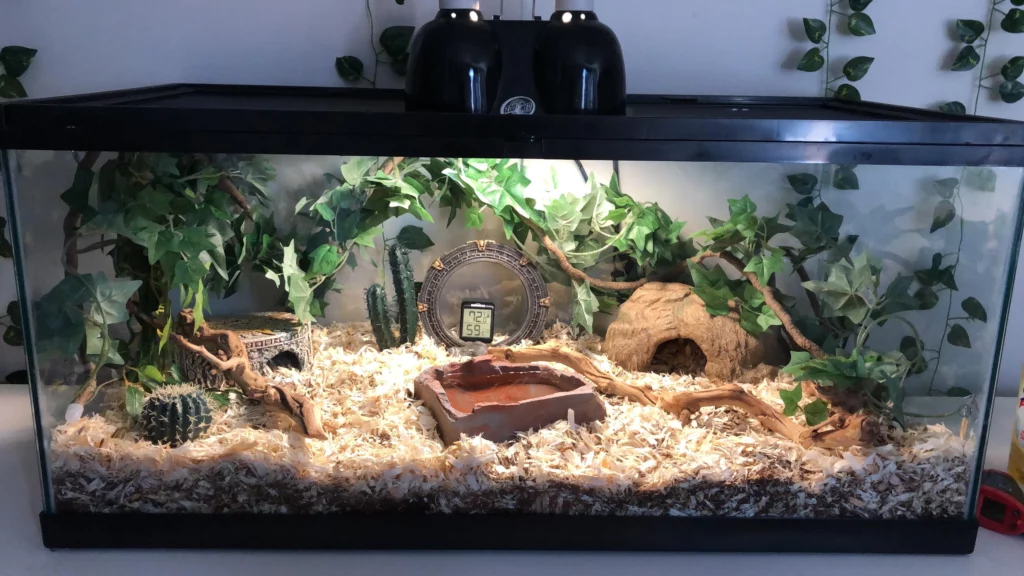
Along with hiding places and suitable substrates, lavender corn snakes need some other decorations and luxuries for them to truly live happily. A shallow and heavy water dish is a must-have for your pet. The dish should be shallow enough for the snake to easily get in and out of, along with being heavy enough so that it can’t tip it over.
Along with serving as a source of fresh drinking water, lavender corn snakes like to occasionally relax in the dish, and it will help ease their shedding process.
Branches are yet another essential decorative item for your pet’s terrarium. Having a couple of climbing branches securely positioned in their tank will give them exercise, along with providing a fun activity for your lavender corn snake that they could have enjoyed in the wild. Plants are another important inclusion to your pet’s habitat.
Lavender corn snakes are a very active breed, so branches will give them the opportunity they need to relieve some energy and play around. Plus, it’ll encourage your pet to move more often, giving you increased entertainment as well.
Although it might be tempting to use fake or plastic plants since they don’t require much maintenance, having live plants positioned around your pet’s enclosure is the more natural and healthy option. Plants provide lavender corn snakes with scents and textures to stimulate their senses, along with making their tank more beautiful and appealing to you.
Although they don’t need special UV lighting, the temperature of a lavender corn snake’s terrarium should be closely monitored. A tank’s ideal temperature should be between 78 and 85 degrees Fahrenheit, though there should be a basking or warm area of around 90 degrees and a cool zone of around 75 degrees.
Tank Temperature
Ceramic heaters and heating lamps can be used to control the temperature within your pet snake’s tank. Along with monitoring the temperature of their tank, a lavender corn snake’s enclosure should have a controlled humidity level. Keeping the humidity between 65% and 75% will help your snake be comfortable and shed its skin easier.
It’s recommended that you use a hygrometer to monitor the humidity of the lavender corn snake’s enclosure. Spritzing the tank with water from a spray bottle, placing a wet hide inside, or setting the water bowl beneath a heat lamp are all great ways to increase moisture levels.
If you intend to breed your lavender corn snake then the female will need to enter a state of brumation. Attempting to breed snakes without having them enter brumation could make the breeding process too hard for their bodies.
Expert Tip: Experts recommend entering your snakes into a state of brumation between December and February, giving them a three-month period where the temperature is kept between 42 degrees and 59 degrees.
This might seem too cold for your pet snake considering their regular recommended temperatures, but corn snakes experience cold habitats naturally in the wild, so your lavender corn snake will be fine so long as you don’t extend the period beyond three months.
Use a spray bottle to moisten the tank once both snakes wake up, then add the male lavender snake to the female’s tank. If both snakes intertwine with one another, then their mating has begun. Only breed snakes that are already healthy before brumation.
Diet
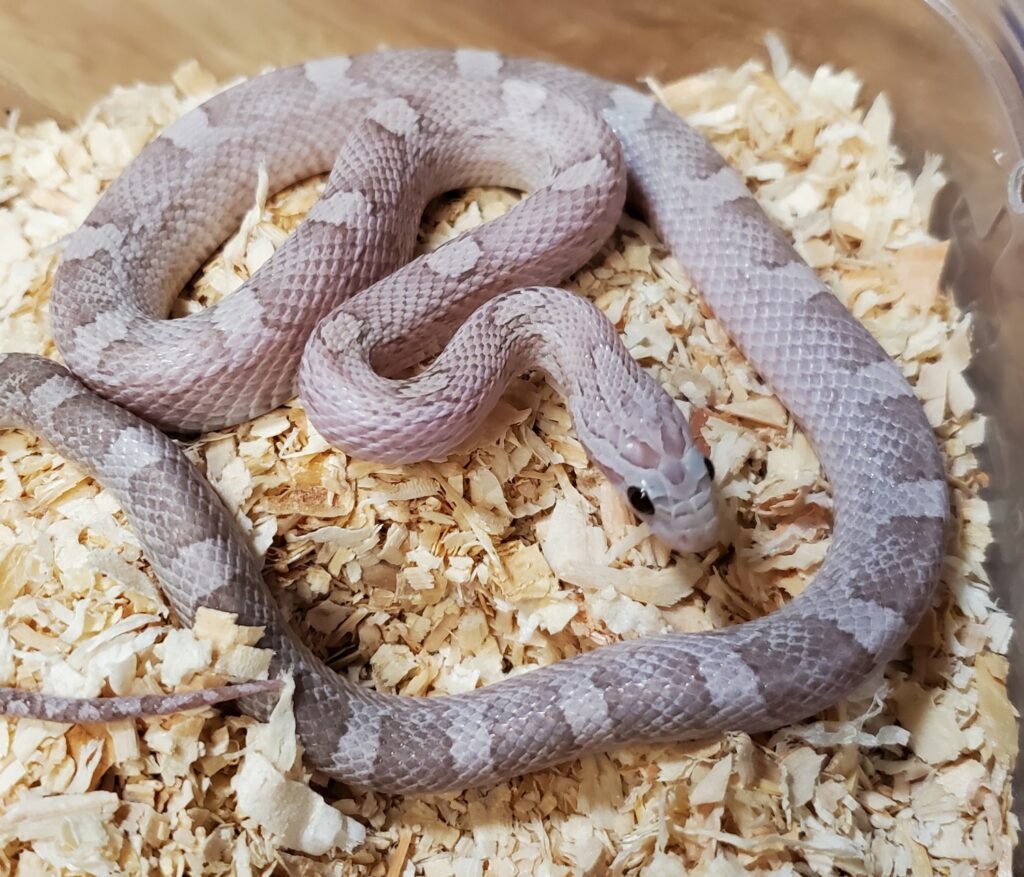
Lavender Corn Snakes have a very simple diet of mice and small rats. They require no fruits, insects, or supplements. It’s recommended that you purchase pre-killed frozen mice, which are easy to come by.
Being pre-killed and frozen means that there’s less chance that your pet snake will get parasites from its meals, and eating the mice whole allows for the snake to get all the calcium it needs. Hatchlings should be fed at least once every five to seven days, but you should only feed them once every 7 to 10 days once they reach 18 inches in length.
An adult corn snake should be fed one or two mice every 10 to 14 days. Keep a close eye on your pet lavender snake’s feeding habits and adjust their feeding periods depending on how much they consume and how hungry they are. The occasional quail egg makes for a great treat but only feed this to them occasionally.
Keeping your pet lavender corn snake healthy should be a high priority, but it’s not difficult. Giving them a steady diet of mice, monitoring their tank’s temperature and humidity levels, and making sure they have all the required items in their enclosure to make them happy should be enough to keep them healthy.
Diseases
The most common problems for lavender corn snakes involve shedding. Increase the humidity in their tank once they begin to shed to decrease the likelihood of health complications, but you can use tweezers to help remove stubborn bits of shed skin that won’t come off. Bacteria can grow on any pieces that are stuck to the snake’s body.
Another and probably less stressful way to help a snake shed stubborn skin is to let it slither around a moist towel. This will soften up the snake’s shed and the towel will catch the scales that come off. making it easier to clean. Pustular dermatitis, also known as scale rot and blister disease, is when blisters form beneath the scales.
Keeping their enclosures clean is a great way to keep your pet lavender snake from developing this illness, but it’s recommended that you take them to a vet if they do.
As previously mentioned, pet stores carry substrates that could be toxic to lavender corn snakes. This isn’t the only problem to be found when purchasing your pet snake from a pet store. The employees might not be knowledgeable about how to properly care for a lavender corn snake, so they could give you bad or potentially harmful information.
This is why it’s recommended to buy lavender corn snakes from reputable breeders or to breed your own.
How often can you handle a Lavender Corn snake?

Lavender corn snakes are easy to handle due to their friendly and docile nature. It’s recommended that you give your new pet some time to settle into its enclosure before you start handling them, usually about one to two weeks. You shouldn’t handle your lavender corn snake until it starts eating regularly, but you can still watch it from outside the tank.
Once your pet is ready to be handled, take things slowly so that you don’t scare it. Start handling it for five minutes, then slowly work your way up to half an hour. The longest you should ever handle your snake is an hour, or else it will start to get too cold. Make sure your pet is awake before handling it by gently tapping it with a paper towel, otherwise you might startle it.
You’ll know it’s awake if its tongue starts flicking out of its mouth. Do not handle your snake until 48 hours after it’s eaten, or else it might expel its contents, creating a mess and upsetting your pet. Always approach it from the side and never from above, or else it might mistake you for a predator. Make sure your snake is calm before and after handling it.
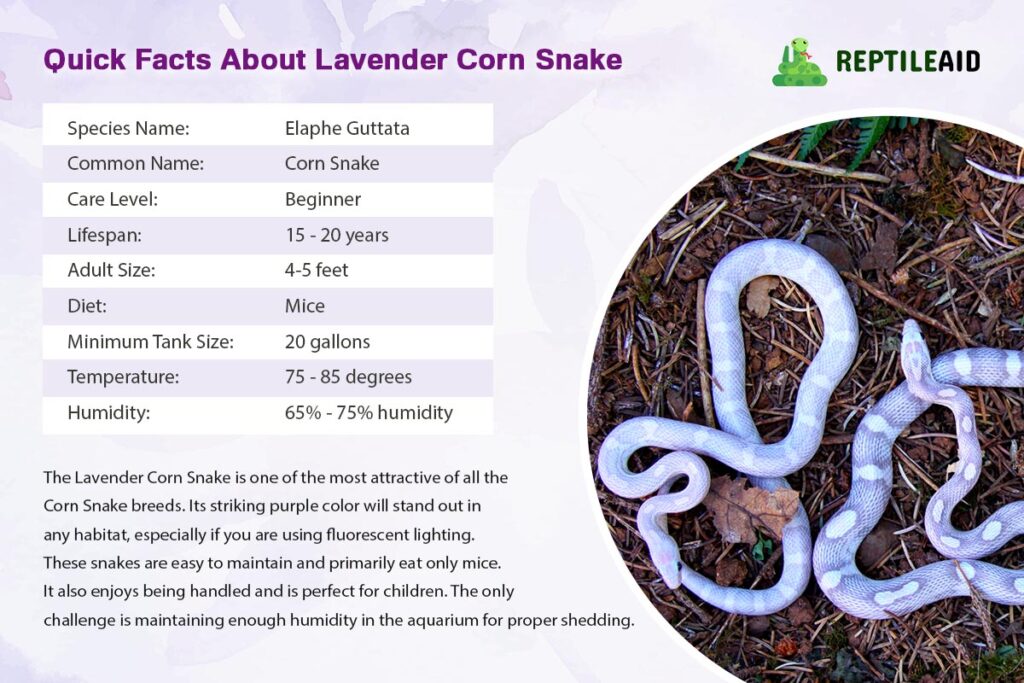
Conclusion
In conclusion, lavender corn snakes are one of the easiest pets to handle. They require high humidity but ensuring that their needs are met means that your pet will rarely if ever be ill. Keep them in 20-gallon or larger tanks, away from other lavender corn snakes unless you’re planning to breed them, monitor their temperature closely, and feed them pre-killed frozen mice.
It’s preferable to buy your snake from a reputable breeder since they’re more likely to be healthy than if you bought them from a pet store. Give them plenty of time to adjust before handling them, and you’ll have a friendly and active buddy.
